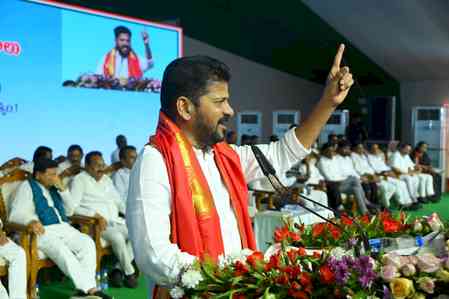Navratri: Harmonising ancient wisdom with modern understanding
Navratri, a significant festival among Hindus, derives its name from the Sanskrit term meaning 'time of nine nights'. During these ten days and nine nights, devotees worship Shakti/Devi.

New Delhi, April 5 (IANS) Navratri, a significant festival among Hindus, derives its name from the Sanskrit term meaning 'time of nine nights'. During these ten days and nine nights, devotees worship Shakti/Devi.
Navratri occurs four times annually, during the lunar months of Chaitra, Magh, Ashadha, and Ashwin (Kartik) from Pratipada to Navami.
Chaitra hosts the Vasantik or Vasantiya Navratri, while Ashwin marks the Shardiya Navratri. Navratri during Magh and Ashadha is known as Gupt Navratri.
The festival concludes with the immersion of the Durga idol on Dussehra.
Notably, there is a three-month gap between each Navratri celebration.
In the context of Hinduism, the practice of worshipping feminine energy (shakti), represented by nine Goddesses, for nine consecutive days during festivals, is unmatched by any similar practice in other religions.
This distinctive aspect underscores the central role of Goddess worship within Hindu observances, showcasing the deep reverence for women and femininity embedded in Hindu culture since antiquity.
Across epochs, Hinduism has boasted the most pronounced presence of the divine feminine among global religions, signifying an enduring legacy of empowerment and reverence for the feminine essence.
The celebration of Navratri embodies the reverence for feminine energy (shakti) depicted in Hindu scriptures. Just as the Rigveda glorifies feminine energy as the essence of the universe, Navratri celebrates the divine feminine through Goddess Durga, Lakshmi, and Saraswati.
These goddesses symboliSe purification cycles, mirroring the journey of purification depicted in ancient texts.
The first cycle, represented by Goddess Durga, purifies the physical realm, akin to the glorification of feminine energy as the creator in Hindu scriptures.
Similarly, the second cycle, led by Goddess Lakshmi, focuses on emotional purification, aligning with the empowering depiction of women in Hindu texts.
Finally, the third cycle, guided by Goddess Saraswati, signifies the purification of the mind, reflecting the supreme governing principle of the cosmos attributed to the feminine in Vedic literature.
Thus, Navratri's rituals echo the profound respect and celebration of women as formidable and empowering entities in Hinduism, as depicted in ancient scriptures.
Why should we seize this opportunity to purify our bodies and minds?
Let's delve into the scientific rationale behind Navratri. One distinguishing feature of Hindu festivals is their inherent connection to significant astronomical events or transitions.
Navratri aligns with crucial astronomical events like Equinoxes and Solstices, which are pivotal in marking the change of seasons.
During the equinox, the sun aligns directly with the equator, creating approximately equal lengths of daylight and darkness worldwide.
This celestial event, derived from the Latin words "equity" and "nox" meaning equal night, marks a balance between light and darkness, with most places experiencing 12 hours of each.
At the equator, the sun is directly overhead during these equinoxes, occurring only twice a year when the Earth's axis is neither tilted towards nor away from the sun, resulting in nearly equal amounts of daylight and darkness across latitudes.
They match well with our body's internal clock, called the circadian rhythm, which dictates when we sleep, wake, and perform other biological functions.
Our internal clock runs slightly longer than a 24-hour day but adjusts to the environment's light-dark cycle. This adjustment, known as entrainment, prevents our cycles from drifting.
Balanced lightness and darkness during equinoxes keep our circadian system stable, ensuring better sleep and well-being.
Physiologically, hormonal shifts occur during this time, influencing various biological cycles and promoting inner transformation.
With rising consciousness during Navratri meditations aids in decluttering the mind of negative emotions such as fear, anger, and attachment, fostering mental well-being.
The March equinox also heralds spring, symbolizing renewal and rejuvenation.
Across cultures, this time is celebrated as nature's awakening, with trees and plants completing their growth cycle, adorned with vibrant spring foliage or blossoms before the arrival of summer.
The eternal and limitless spirit (soul) journeyed through the ages, acting as an unending source of energy in the universe.
Navratri, the nine sacred nights of India's spiritual festival through fasting, prayer, chanting, and meditation offer a chance to convert negativity into positivity.
These significant nights mark a period for awakening, integrating, and aligning the nine chakras across the mind, body, and spirit.
During Navratri, the subtle energies enveloping the surroundings aid in guiding one's path towards spiritual enlightenment, forging a link between personal awareness and the divine, auspicious collective consciousness.
This connection evokes positive attributes within us, dismantling lethargy, conceit, fixation, desires, and repulsions.
As negative emotions dissipate, replaced by transformative energies, we embark on a journey of profound rejuvenation throughout the auspicious nine nights.
Interestingly, the concept of feminine energy finds a parallel in the biological realm through mitochondria, often referred to as the powerhouse of the cell. Mitochondria, inherited from the maternal DNA, play a crucial role in providing energy to the human body.
This connection underscores the deep reverence for the feminine essence embedded in Hindu culture.
During Navratri, devotees engage in rituals such as fasting, prayer, chanting, and meditation, seeking spiritual enlightenment and purification.
These practices have been likened to intermittent fasting, which has been associated with mitochondrial rejuvenation.
Fasting triggers processes like autophagy and mitochondrial biogenesis.
Autophagy clears out damaged mitochondria, while biogenesis stimulates the formation of new, healthy ones. This renewal process parallels the spiritual journey of Navratri, where devotees strive for inner purification and renewal.
Moreover, intermittent fasting of Navratri enhances mitochondrial efficiency and function, reducing oxidative stress and promoting cellular health.
Similarly, Navratri rituals aim to cleanse the mind, body, and spirit, offers an ideal opportunity to sync and balance the internal and external energy centers, fostering spiritual integration and harmony.
Navratri holds profound significance, intertwining spiritual, social, and scientific dimensions.
From a social perspective, traditionally in Bharat, there was no concept of weekends or Sundays, so the Hindu festivals like Navratri used to provide a respite from the rigors of daily life, reminding individuals to pause and reconnect through community interactions, revitalising old relationships and fostering new connections amidst seasonal change.
The attributes like strength and stability, devout asceticism, courage, protection, and determination are essential qualities for navigating life's challenges. Additionally, the ability to combat evils, create positive change, and embody purity and recovery contribute to a well-rounded and evolved existence.
Each of these attribute symbolised by the nine forms of the divine Goddess Durga is integral to achieving spiritual growth, fulfilment, and ultimately, a harmonious and evolved life.
In the rich tradition of Hinduism in Bharat, the intertwining of science and culture is not only evident but celebrated.
Navratri, with its profound spiritual significance and scientific underpinnings, exemplifies this harmonious co-existence.
As devotees come together to honour the divine feminine and embark on a journey of purification and enlightenment, they simultaneously embrace the scientific insights that guide their practices.
In this fusion of ancient wisdom and modern understanding, Hinduism in Bharat continues to thrive, offering a timeless path to spiritual growth and cultural richness.
(The writer is a Ph.D in sociology and has authored books on India History)


 IANS
IANS 











